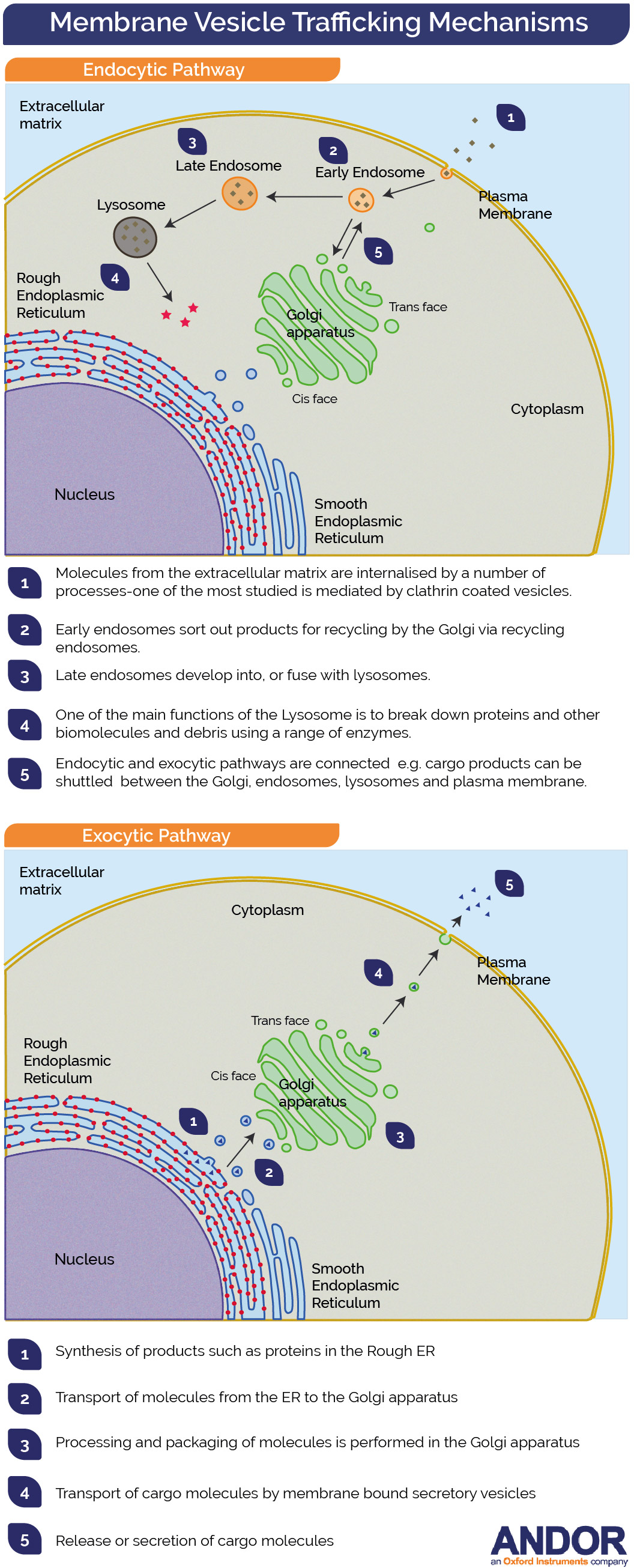Resources
 Part of the Oxford Instruments Group
Part of the Oxford Instruments Group
Expand
Collapse
 Part of the Oxford Instruments Group
Part of the Oxford Instruments Group
Membrane vesicle trafficking (also called cell trafficking) is the transport of cell products between subcellular components like the Endoplasmic Reticulum (ER) and Golgi apparatus via membrane encapsulated vesicles, to and from the plasma membrane and other specific cell locations. Many of these processes involve the release of cellular products at the plasma membrane, or uptake of material from the extracellular matrix. Such pathways are an integral part of cell function being involved in the controlled release of neurotransmitters like GABA as well as hormones and cytokines. Membrane vesicle mediated trafficking is also vital to the normal function of the immune system e.g. degranulation by neutrophils (release of proteolytic enzymes), secretion of mucus and in cell signalling networks.

Studying these cell trafficking pathways is challenging from a technical perspective. Techniques such as TIRF (Total Internal Reflectance Fluorescence), or fluorescence resonance energy transfer (FRET) are often used to provide the resolution, and the means to follow protein interactions in situ respectively. Given the relatively small size of the cellular components involved and the techniques required to image them, the resultant emitted light levels can be very low, making high sensitivity detectors essential. In addition many of these processes – such as budding from membranes or fusion events are dynamic making high speed imaging essential for capturing these events effectively.
The latest back-illuminated sCMOS cameras provide exceptional sensitivity and capable of high frame rates making them suitable for imaging dynamic samples that have low fluorophore emission levels.
Andor highly recommends the Sona back-illuminated sCMOS camera (Sona 4.2B-6) for membrane vesicle trafficking experiments. Sona offers the perfect combination of high sensitivity, speed and exceptional field of view. With a near perfect 95% QE and low noise, the Sona is highly sensitive at the low light levels that are inherent to these studies. The 6.5 µm pixel is perfectly suited to resolving features in full clarity with the latest high NA objectives. Sona 4.2B-6 is fast – up to 74 fps at full resolution (2048 x 2048), and regions of interest can be used to boost speeds significantly higher for when temporal resolution is important e.g. 587 fps at 256 x 256. Image data can subsequently be visualised, processed and analysed using Imaris software.
| Key Requirement | Membrane Trafficking Studies Solution: Sona 4.2B-6 |
| Visualise the weak signals of membrane vesicle trafficking components | Sona is perfect for detecting small changes in signal intensity of fluorescent labels of target molecules in FRET and TIRF based experiments. With 95% QE and the deepest cooling, the lowest possible noise is achieved, making Sona the most sensitive sCMOS camera available. Fluorophore levels and exposures can therefore be kept as low as possible for more accurate physiology and reduced photo-toxicity effects. Result – Use low fluorophore and exposures for more accurate cell physiology. |
| Observe the interactions of molecules and membranes. | The Sona is perfectly suited to resolving the full detail of intricate structures and processes under widely used magnifications of 40x and 60x. |
| View dynamic events with excellent temporal resolution | View the intracellular movement and fusion of vesicles and membrane events with excellent temporal resolution. With high sensitivity, it is possible to run at speeds of up to 74 fps at full frame (2048x2048) , ROIs boost speeds even further (e.g. 587 fps at 256x256). Sona lets you view the subtle yet significant changes occurring at the plasma membrane. Result – observe changes in dynamic aspects of the membrane vesicle tracking pathways. |
| Quality and Longevity | Sona comes with Andor’s exclusive UltraVac™ vacuum sensor enclosure. The well proven permanent vacuum process is critical not only for cooling, but for protection of the back-illuminated sensor against moisture and condensates which would otherwise degrade performance over time. Result – Sustained high performance, year after year. |
